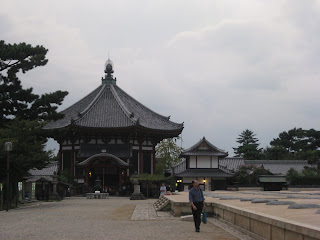
For our two nights in Nara we stayed in a Ryokan, which is a traditional Japanese Inn. 


They also give you pretty awesome bath robes which allowed us to have a little fun.
We also bought some ridiculous Japanese hats to wear around as it seemed to be very popular in Japan to wear strange hats.



According to the legendary history of Kasuga Shrine (discussed below), a mythological god Takemikazuchi arrived in Nara on a white deer to guard the newly built capital of Heijō-kyō. Since then the deer were regarded as heavenly animal to protect the city and the country.
There are also a number of vendors on the street who sell deer crackers. You have to be careful though - as soon as the vendor gives you the deer crackers you get absolutely mauled by deer trying to get a taste. 
Todai-ji
Nara is a fairly small city and we traveled around on foot for basically our whole stay. We decided to take a walking tour of the city and our first stop was the Buddhist temple Todai-ji. 

Todai-ji is home to the great bronze Buddha, known as the Daibutsu to the Japanese (Daibutsu simply means large Buddha in other cultures). 
There were also some accompanying statues and sculptures that were impressive as well
Kofuku-ji
Kofuku-ji was another Buddhist temple that was located just down the street from our ryokan. The five story pagoda, one of the largest remaining pagodas in Japan, was impressive 

The Kasuga Shrine was next on our list. This was a Shinto shrine and was in my opinion the most impressive of the Shinto shrines we visited in Japan. That isn't really saying much as Shinto shrines are by nature unimpressive.
Along the exterior of the shrine there were many stone lanterns that were carved with extreme precision.
Throughout the interior there were numerous bronze lanterns.
Of course, I was always a little unimpressed with Shinto shrines.
I mean you walk through a whole shinto shrine and at the end you see a giant piece of looseleaf paper strung to a stick.
Don't get me wrong, I'm sure the Shinto religion is equal or superior to other religions in substance but it's image could use a visit from Xzibit and good folks at Pimp my Ride.  Hey, maybe they could call it "Pimp my Shrine"
Hey, maybe they could call it "Pimp my Shrine"
HA HA HA!!!!!
Yeah that's not funny.
Anyway, it was at this shrine that I received my fortune.
 I paid my donation and received a fortune drawn by a process that involved shaking a large cylinder shaped container of wooden sticks, each of which had a number on it. The number at the end of the stick let us know the fortune. Traditionally I think instead of sticks they have rolled up pieces of paper but they didn't for this shrine for one reason or another.
I paid my donation and received a fortune drawn by a process that involved shaking a large cylinder shaped container of wooden sticks, each of which had a number on it. The number at the end of the stick let us know the fortune. Traditionally I think instead of sticks they have rolled up pieces of paper but they didn't for this shrine for one reason or another.I was not thrilled with the fortune I received, which was basically a moderately good fortune, but it was better than a bad fortune so I kept it instead of tying to the pine tree, as is custom in Shinto shrines.
Yoshikien Garden

In between other major sites we also stopped by the Yoshikien Japanese Zen garden. 


 Nara is a fairly small city and there is not much that goes on at night, so after hitting up a few bars where we were basically the only patrons we decided to spend a few hours in Sega World playing strange Japanese video games. I just can't get over how weird these arcades are. It's all bright lights, strange music, and loud noises.
Nara is a fairly small city and there is not much that goes on at night, so after hitting up a few bars where we were basically the only patrons we decided to spend a few hours in Sega World playing strange Japanese video games. I just can't get over how weird these arcades are. It's all bright lights, strange music, and loud noises.  Once you get over the strangeness of the whole situation it actually is a really good time. We played a few video games and some air hockey,
Once you get over the strangeness of the whole situation it actually is a really good time. We played a few video games and some air hockey,  but by far my favorite game had to be this Japanese drum game, which is like a Japanese cartoon version of Rock Band.
but by far my favorite game had to be this Japanese drum game, which is like a Japanese cartoon version of Rock Band.

Check the videos...
Waaaaaay too much fun.
We only stayed in Nara for a day and two nights before we headed back to Tokyo.
Overall Nara was a great stop on our trip. It was even smaller than Kyoto which allowed us to really relax and enjoy our time away from work. It had some great attractions, especially the Big Buddha, and it was inexplicably covered with hundreds or thousands of tame deer.
I would definitely recommend stopping in Nara if you are visiting Japan. It is small and can be seen in one day. If nothing else take a train there, buy some fifty cent deer crackers and play that weird Japanese drum video game and get back on the train and be on your way.


























